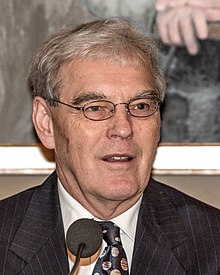Richard Henderson
Richard Henderson CH FRS FMedSci HonFRSC (born 19 July 1945) is a Scottish molecular biologist and biophysicist. He is a pioneer in the field of electron microscopy of biological molecules. He shared the Nobel Prize in Chemistry in 2017 with Jacques Dubochet and Joachim Frank.
Richard Henderson | |
|---|---|
 Henderson during Nobel Prize press conference in Stockholm in 2017 | |
| Born | 19 July 1945 Edinburgh, Scotland |
| Alma mater | |
| Known for | Cryo-electron microscopy |
| Awards |
|
| Scientific career | |
| Fields | |
| Institutions | |
| Thesis | X-Ray Analysis of α-chymotrysin: Substrate and Inhibitor Binding (1970) |
| Doctoral advisor | David Mervyn Blow |
Henderson has worked at the Medical Research Council Laboratory of Molecular Biology (MRC LMB) in Cambridge since 1973, and was its director between 1996 and 2006. He was also a visiting professor at the Miller Institute of the University of California, Berkeley in Spring 1993.[2]
He worked out the structure of bacteriorhodopsin, a molecule in bacteria.[3] The molecule captures energy from light, and uses it to move protons out of the cell. This was the second ever atomic model of a membrane protein. The techniques Henderson developed for electron crystallography are still in use.
Henderson's methods help to solve the structures of several G protein–coupled receptors (GPCRs). They are a large protein family of receptors that detect molecules outside the cell. They activate internal signal transduction pathways. This leads to cell responses to the molecules outside the cell.